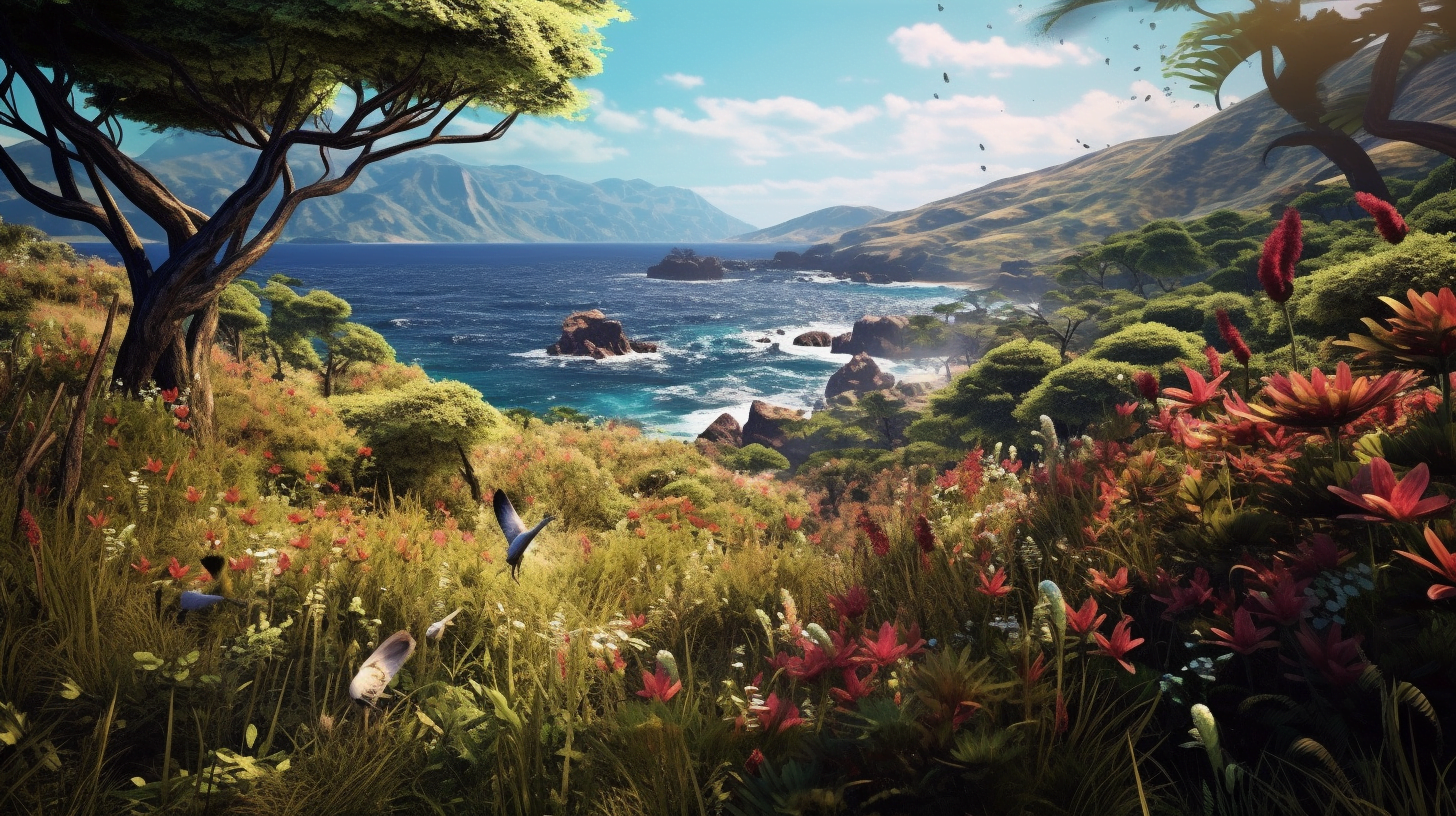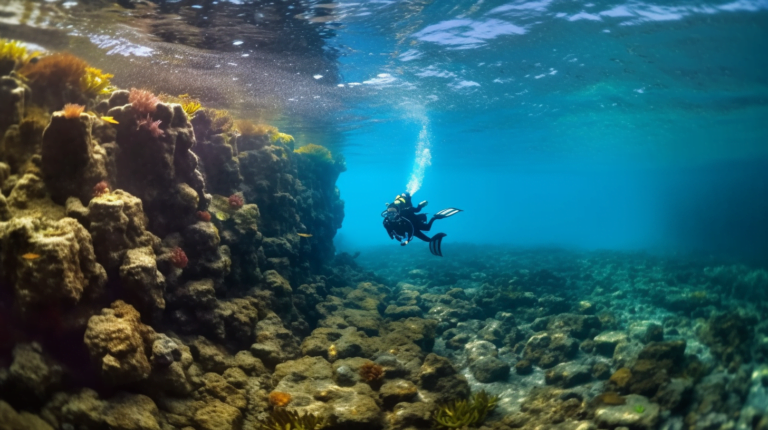Explore the Natural Wonders of Lanai 🌿🦜🐢
Welcome to Lanai, a small island in Hawaii that is a nature lover’s paradise. With its diverse ecosystems, rare flora and fauna, and stunning landscapes, Lanai is a destination that will leave you in awe. Whether you’re a birdwatcher, hiker, or simply enjoy exploring the beauty of nature, Lanai is the perfect place for you.
One of the highlights of Lanai is its unique flora and fauna. From the Munroidendron Racemosum, a rare plant found only on the island, to the Lanai Bighorn Sheep, a species that has been saved from extinction, Lanai offers a glimpse into a world of biodiversity that is rare and precious.
In this article, we’ll explore Lanai’s unique ecosystems, endangered species, and conservation efforts that make this island a truly special destination. So, put on your hiking boots, grab your binoculars, and get ready to experience the beauty of Lanai’s nature.
Key Takeaways
- Lanai’s ecological diversity ranges from dry mesic forests to cloud forests at the summit.
- Lanai is home to unique flora and fauna, such as the Lanai bighorn sheep, Munroidendron Racemosum, Hawaiian Petrel, Red-Tailed Tropicbird, Newell’s Shearwater, Hawaiian spinner dolphins, green sea turtles, and Lanai tree snail.
- Conservation efforts, including habitat restoration, captive breeding, and controlling non-native species, have been implemented to protect Lanai’s unique flora and fauna.
- Visitors can explore Lanai’s natural beauty through guided tours, hiking and trekking, with wildlife watching tips including bringing camera equipment and following posted guidelines or regulations.
Lanai’s Diverse Ecosystems
You’re about to explore Lanai’s diverse ecosystems, where you’ll encounter rare plants and animals found nowhere else in the world. The island’s ecological diversity is truly remarkable, ranging from the dry mesic forests on the lower slopes of Lanaihale to the cloud forests at the summit.
As you explore Lanai’s diverse ecosystems, you’ll notice the striking differences in plant and animal life from one area to the next. However, Lanai’s diverse ecosystems are not immune to the impact of climate change. In recent years, the island has experienced more severe and prolonged droughts, which have led to the decline of some plant species. Additionally, rising sea levels threaten to inundate low-lying areas and destroy critical habitat for many of Lanai’s unique species. Despite these challenges, efforts are underway to protect and conserve Lanai’s diverse ecosystems for future generations.
As you continue your exploration of Lanai’s unique flora and fauna, keep an eye out for the island’s bighorn sheep. These majestic animals were introduced to Lanai in the 1920s and have since become an important part of the island’s ecosystem. But their presence also highlights the delicate balance of nature and the need for conservation efforts to ensure their survival.
Lanai Bighorn Sheep
If you’re lucky enough to catch a glimpse of these majestic creatures, you’ll be reminded of the old saying, ‘still waters run deep.’ The Lanai bighorn sheep is a true symbol of grace and strength.
They have adapted well to the harsh, arid environments of Lanai, where they roam freely among the rocky ridges and steep slopes. These sheep are known for their incredible agility and speed, making them a true wonder to watch in their natural habitat.
To ensure the survival of the Lanai bighorn sheep, conservation strategies have been implemented to protect their population. One of the most successful strategies has been the relocation of sheep to other islands, such as Maui and Hawaii. This has helped to prevent overgrazing and competition for resources on Lanai, while also providing new habitats for the sheep to thrive in.
Additionally, habitat restoration efforts have been made to improve the quality of grazing lands and reduce the impact of invasive species.
Overall, the Lanai bighorn sheep is a fascinating species that plays an important role in the island’s unique ecosystem. Their ability to adapt to the harsh conditions of Lanai is a testament to their resilience and strength.
As conservation efforts continue, we can hope to see their population grow and thrive for generations to come. With that said, let’s move on to the next exciting topic: munroidendron racemosum.
Munroidendron Racemosum
Get ready to discover the fascinating world of Munroidendron Racemosum, a plant species that will leave you in awe with its unique features. This rare plant, also known as Lanai Tree Heliotrope, can only be found on the island of Lanai, Hawaii.
The Munroidendron Racemosum is a small tree that can grow up to 30 feet tall and has a trunk diameter of up to 10 inches. The Munroidendron Racemosum habitat is restricted to the dry forests of Lanai.
This species of tree is a crucial part of the ecosystem as it provides shade and shelter for many animals such as birds and insects. Unfortunately, the Munroidendron Racemosum is threatened by deforestation, habitat loss, and invasive species. Conservation efforts have been made to protect the Munroidendron Racemosum from extinction, including the establishment of protected areas and reforestation projects.
Protecting the Munroidendron Racemosum is essential to maintain the balance of Lanai’s ecosystem. Its unique characteristics and importance make it a crucial species to preserve. As you continue to explore the flora and fauna of Lanai, take note of how vital each species is to the island’s ecosystem.
Next, we’ll dive into the endangered bird species that call Lanai their home.
Lanai’s Endangered Bird Species
As you explore Lanai’s unique flora and fauna, don’t forget to keep an eye out for the island’s endangered bird species.
The Hawaiian Petrel, Red-Tailed Tropicbird, and Newell’s Shearwater are just a few of the birds that call Lanai home, but they are facing threats to their populations.
Learn about these fascinating birds and what you can do to help protect them during your visit to the island.
Hawaiian Petrel
The Hawaiian Petrel, also known as ‘ua‘u, is a critically endangered bird species endemic to Hawaii that only nests in the mountainous regions of Maui and Hawaii Island, with an estimated population of fewer than 50,000 breeding pairs. These birds are nocturnal and spend most of their time at sea, only returning to land to breed. Unfortunately, their nesting grounds have been severely impacted by human activities, such as development, habitat degradation, and predation by introduced species like rats and feral cats.
Conservation efforts are currently underway to protect the Hawaiian Petrel, including the establishment of protected areas and predator control programs. Additionally, breeding programs have been established to increase the petrel population and reintroduce them to areas where they have disappeared. These efforts are crucial in ensuring the survival of this unique and important species. Moving on to the next section, let’s take a closer look at the red-tailed tropicbird and its characteristics.
Red-Tailed Tropicbird
As you bid farewell to the Hawaiian Petrel, turn your attention to the Red-Tailed Tropicbird. This elegant bird is easily recognized by its striking red tail feathers and long, white tail streamers that effortlessly trail behind it as it soars through the skies.
The Red-Tailed Tropicbird is a common sight on Lanai, where it can be found nesting in steep, rocky cliffs along the island’s coastline. During breeding season, these birds put on a spectacular display, with males performing elaborate courtship dances and females laying a single egg in their nest.
After breeding season, the Red-Tailed Tropicbird embarks on a long migration to warmer waters, where it spends the rest of the year feeding and resting before returning to Lanai once again.
As you marvel at the beauty of the Red-Tailed Tropicbird, prepare yourself for another fascinating bird that calls Lanai home – the Newell’s Shearwater.
Newell’s Shearwater
Get ready to witness the impressive flight of the Newell’s Shearwater, a seabird that can only be found in Hawaii. This bird is a true marvel of nature, with its unique abilities and adaptations that allow it to soar through the skies with grace and ease. As you watch the Newell’s Shearwater take flight, you’ll be amazed at its wingspan, which can reach up to 36 inches, and its ability to fly for long distances without stopping.
To fully appreciate the Newell’s Shearwater, it’s important to understand its impact on Lanai’s ecosystem and the importance of its conservation. This bird is a critical part of the island’s biodiversity, and its presence helps to maintain a healthy and balanced ecosystem. Unfortunately, the Newell’s Shearwater is currently facing numerous threats, including habitat loss, predation by introduced species, and light pollution. To protect this unique species and ensure its survival, efforts are underway to reduce these threats and increase public awareness of the importance of conservation.
As you move on to explore other unique flora and fauna on Lanai, keep in mind the important role that each species plays in the island’s delicate ecosystem. By learning about and appreciating the natural wonders around you, you can help to ensure that they will continue to thrive for generations to come.
Other Unique Flora and Fauna
You won’t be disappointed with the abundance of unique flora and fauna on Lanai.
Explore the island’s waters and you may be lucky enough to spot Hawaiian spinner dolphins and green sea turtles.
On land, keep an eye out for the colorful and rare Lanai tree snails, which can only be found on this small island.
Hawaiian Spinner Dolphins
Don’t miss out on the opportunity to witness the playful Hawaiian Spinner Dolphins in their natural habitat during your visit to Lanai. These dolphins are known for their acrobatic displays, spinning up to seven times in the air before splashing back into the water. They are also known for their social behavior, often swimming in groups of 20 or more.
Conservation efforts for Hawaiian spinner dolphins have been implemented in Lanai and throughout Hawaii, as their populations have declined due to human activity such as overfishing and boat traffic. It is important to remember to respect these animals and their habitat by keeping a safe distance and avoiding disrupting their natural behavior. Witnessing these majestic creatures in their natural habitat is truly a once in a lifetime experience that you won’t want to miss during your trip to Lanai.
As you move on to the next section about ‘green sea turtles’, you’ll continue to explore the unique and diverse flora and fauna of Lanai.
Green Sea Turtles
If you’re lucky, you might spot a green sea turtle during your swims in the crystal-clear waters off the coast of Lanai. Can you imagine swimming alongside these ancient creatures as they gracefully glide through the water?
These majestic animals have been around for millions of years and can weigh up to 700 pounds! The green sea turtles are known to visit Lanai’s shores to nest during the summer months. The island’s conservation efforts have been successful in protecting their nesting sites, and visitors are reminded to keep a safe distance from these gentle giants.
The green sea turtles are just one example of the unique flora and fauna found on Lanai. Another fascinating creature is the Lanai tree snail, which is only found on this island.
Let’s learn more about these tiny but mighty creatures and their importance to the ecosystem.
Lanai Tree Snails
The Lanai tree snail, with its striking colors and intricate shell, is a small but vital part of the island’s delicate ecosystem. These snails are endemic to Lanai, meaning they can only be found on this island. Unfortunately, their population has drastically declined due to habitat loss, non-native predators, and environmental factors.
To protect the Lanai tree snails, conservation efforts have been put in place. Here are some ways that individuals and organizations are working towards preserving this unique species:
- Habitat restoration projects are taking place to recreate the snails’ natural environment.
- Captive breeding programs have been established to increase the snails’ population.
- Efforts are being made to control the introduction of non-native species that prey on the snails.
- Education and awareness campaigns are being conducted to inform the public about the importance of the Lanai tree snails.
By implementing these conservation efforts, we can help protect the Lanai tree snails and ensure that they continue to thrive on the island.
Now, let’s take a closer look at the steps being taken to restore their habitat.
Conservation Efforts
Preserving Lanai’s unique flora and fauna is a top priority for the island’s conservation efforts, with local organizations working tirelessly to protect the delicate ecosystem. Through various conservation initiatives, such as habitat restoration and species reintroduction programs, these organizations aim to conserve the island’s biodiversity for future generations to enjoy.
The community is also heavily involved in these efforts, with residents and visitors alike volunteering their time to help conserve Lanai’s natural treasures. One significant conservation effort on Lanai is focused on the endangered Lanai tree snail, a species found only on the island. Due to habitat loss and the introduction of non-native predators, the Lanai tree snail population has declined dramatically in recent years.
However, through a combination of captive breeding programs and habitat restoration projects, conservationists are working to increase the snail’s numbers and protect their habitat. These efforts have already shown promising results, with the snail population slowly but steadily increasing.
Overall, the conservation efforts on Lanai demonstrate the island’s commitment to preserving its unique flora and fauna for future generations. By involving the community and implementing innovative conservation initiatives, conservationists hope to protect the island’s delicate ecosystem and ensure that Lanai remains a haven for nature lovers.
If you’re planning a trip to Lanai, experiencing the island’s nature firsthand is a must. From hiking trails to wildlife viewing, there are countless ways to immerse yourself in Lanai’s natural beauty.
Experience Lanai’s Nature
Ready to immerse yourself in the natural wonders of Lanai? Take advantage of guided tours that will lead you to the island’s most picturesque spots. If you’re up for a challenge, go hiking or trekking and see the stunning landscapes up close.
Keep an eye out for the island’s unique wildlife with these helpful wildlife watching tips.
Get ready for an unforgettable experience in Lanai’s nature!
Guided Tours
Joining a guided tour through Lanai’s breathtaking landscapes is like embarking on a thrilling adventure with a knowledgeable guide who can unlock the secrets of the island’s unique flora and fauna.
There are two types of tours available: private and group tours. Private tours offer a more personalized experience with a guide who can cater to your specific interests and preferences. Group tours, on the other hand, are more affordable and provide the opportunity to meet other nature enthusiasts.
The best time to visit Lanai for guided tours is during the dry season from April to September. This is when the weather is most favorable for outdoor activities and the flora and fauna are at their peak.
Regardless of when you visit, be sure to dress appropriately and bring plenty of water and sunscreen. With a guided tour, you’ll be able to explore the island’s unique landscapes and ecosystems while learning about the fascinating flora and fauna that call Lanai home.
And if you’re up for more adventure, the next section will cover hiking and trekking options on the island.
Hiking and Trekking
If you’re looking for a more adventurous way to explore Lanai’s unique flora and fauna, then hiking and trekking might be perfect for you. Lanai offers a variety of trails that cater to both beginners and experienced hikers. Before you embark on your hiking journey, make sure to prepare your outdoor gear and review trail safety tips to ensure a safe and enjoyable experience.
Lanai’s best hiking routes offer breathtaking views of the island’s natural beauty. The Munro Trail, for example, is a popular and well-maintained trail that takes you through pine forests and up to the island’s highest peak, Lanaihale. The Koloiki Ridge Trail is another popular option that offers stunning views of the Pacific Ocean and neighboring islands. So, grab your hiking boots and a sense of adventure, and explore the beauty of Lanai on foot.
As you trek through the island’s rugged terrain, keep in mind some wildlife watching tips to make the most out of your hiking experience.
Wildlife Watching Tips
Get ready to enhance your hiking experience by spotting some of Lanai’s diverse wildlife with these helpful tips. As you venture out into the island’s natural habitats, make sure to bring along your camera equipment to capture stunning shots of the unique flora and fauna. Whether you’re hoping to snap a photo of one of the island’s endemic bird species or catch a glimpse of a Hawaiian monk seal lounging on the beach, having the right equipment will ensure that you’re prepared for any wildlife encounter.
As you embark on your wildlife watching adventure, it’s important to remember to practice ethical wildlife watching. This means keeping a safe distance from animals, avoiding disturbing their natural behavior, and respecting their space. Additionally, be sure to stay on marked trails and follow any posted guidelines or regulations.
By following these tips, you can ensure that you have a memorable and responsible wildlife watching experience on Lanai.
Conclusion
Congratulations! You’ve just completed a nature lover’s guide to Lanai’s unique flora and fauna.
You’ve discovered the island’s diverse ecosystems, from its towering sand dunes to its lush forests, and learned about the endangered bird species and Munroidendron Racemosum that call this island home.
But Lanai is more than just a destination for nature enthusiasts. It’s a symbol of the delicate balance between human development and environmental conservation.
By supporting the island’s conservation efforts and experiencing its natural wonders firsthand, you’re helping to preserve its beauty for generations to come.
So go ahead, take a hike through the misty forests, spot a Lanai bighorn sheep grazing on the hillside, and immerse yourself in the island’s unique flora and fauna.
Lanai is waiting for you to discover its secrets, and by doing so, you’re helping to protect this precious gem in the Pacific.







